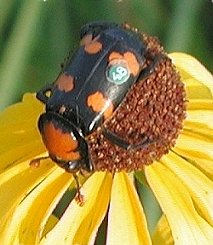
Burying beetles or sexton beetles, genus Nicrophorus, are the best-known members of the family Silphidae. Most of these beetles are black with red markings on the elytra (forewings). Burying beetles are true to their name—they bury the carcasses of small vertebrates such as birds and rodents as a food source for their larvae, this makes them carnivorous. They are unusual among insects in that both the male and female parents take care of the brood.

Decomposition or rot is the process by which dead organic substances are broken down into simpler organic or inorganic matter such as carbon dioxide, water, simple sugars and mineral salts. The process is a part of the nutrient cycle and is essential for recycling the finite matter that occupies physical space in the biosphere. Bodies of living organisms begin to decompose shortly after death. Animals, such as earthworms, also help decompose the organic materials. Organisms that do this are known as decomposers or detritivores. Although no two organisms decompose in the same way, they all undergo the same sequential stages of decomposition. The science which studies decomposition is generally referred to as taphonomy from the Greek word taphos, meaning tomb. Decomposition can also be a gradual process for organisms that have extended periods of dormancy.

Taphonomy is the study of how organisms decay and become fossilized or preserved in the paleontological record. The term taphonomy was introduced to paleontology in 1940 by Soviet scientist Ivan Efremov to describe the study of the transition of remains, parts, or products of organisms from the biosphere to the lithosphere.

A lye is an alkali metal hydroxide. Traditionally it was obtained by using rainwater to leach wood ashes, which are strongly alkaline and highly soluble in water, of their potassium hydroxide (KOH), producing lye water, a caustic basic solution. Then the lye water would either be used as such, as for curing olives before brining them, or evaporated of water to leave crystalline lye behind. "Lye" most accurately refers to sodium hydroxide (NaOH), but historically has been conflated to include other alkali materials, most notably potassium hydroxide.
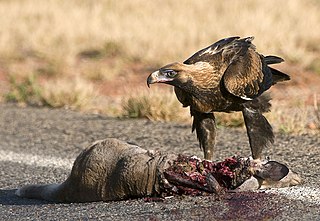
Carrion, also known as a carcass, is the decaying flesh of dead animals.

Trogidae, sometimes called hide beetles, is a family of beetles with a distinctive warty or bumpy appearance. Found worldwide, the family includes about 300 species contained in four or five genera.

Dermestidae are a family of Coleoptera that are commonly referred to as skin beetles. Other common names include larder beetle, hide or leather beetles, carpet beetles, and khapra beetles. There are over 1,800 species described.

A horn is a permanent pointed projection on the head of various animals that consists of a covering of keratin and other proteins surrounding a core of live bone. Horns are distinct from antlers, which are not permanent. In mammals, true horns are found mainly among the ruminant artiodactyls, in the families Antilocapridae (pronghorn) and Bovidae. Cattle horns arise from subcutaneous connective tissue and later fuse to the underlying frontal bone.
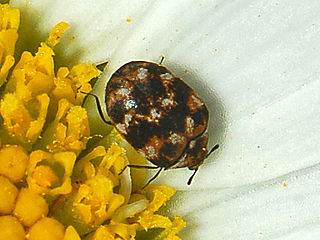
The varied carpet beetle is a 3 mm-long beetle belonging to the family Dermestidae. They are a common species, often considered a pest of domestic houses and, particularly, natural history museums, where the larvae may damage natural fibers and can damage carpets, furniture, clothing, and insect collections. A. verbasci was also the first insect to be shown to have an annual behavioral rhythm and to date remains a classic example of circannual cycles in animals.

Maceration is a bone preparation technique whereby a clean skeleton is obtained from a vertebrate carcass by leaving it to decompose inside a closed container at near-constant temperature. This may be done as part of a forensic investigation, as a recovered body is too badly decomposed for a meaningful autopsy, but with enough flesh or skin remaining as to obscure macroscopically visible evidence, such as cut-marks. In most cases, maceration is done on the carcass of an animal for educational purposes.
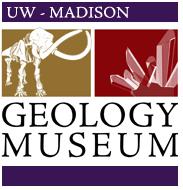
The UW–Madison Geology Museum (UWGM) is a geology and paleontology museum housed in Weeks Hall, in the southwest part of the University of Wisconsin–Madison campus. The museum's main undertakings are exhibits, outreach to the public, and research. It has the second highest attendance of any museum at the University of Wisconsin–Madison, exceeded only by the Chazen Museum of Art. The museum charges no admission.

Dermestes is a genus of beetles in the family Dermestidae, the skin beetles. The genus is distributed worldwide.

Dermestes maculatus is a species of beetle with a worldwide distribution, being present on all continents except Antarctica. In Europe, it is present in all countries.
Home-stored product entomology is the study of insects which infest foodstuffs stored in the home. It deals with the prevention, detection and eradication of the pests.
Entomological evidence is legal evidence in the form of insects or related artifacts and is a field of study in forensic entomology. Such evidence is used particularly in medicolegal and medicocriminal applications due to the consistency of insects and arthropods in detecting decomposition quickly. Insect evidence is customarily used to determine post-mortem interval (PMI) but can also be used as evidence of neglect or abuse. It can indicate how long a person was abused/neglected as well as provide important insights into the amount of bodily care given to the neglected or abused person.

A zoological specimen is an animal or part of an animal preserved for scientific use. Various uses are: to verify the identity of a (species), to allow study, increase public knowledge of zoology. Zoological specimens are extremely diverse. Examples are bird and mammal study skins, mounted specimens, skeletal material, casts, pinned insects, dried material, animals preserved in liquid preservatives, and microscope slides. Natural history museums are repositories of zoological specimens

Conservation-restoration of bone, horn, and antler objects involves the processes by which the deterioration of objects either containing or made from bone, horn, and antler is contained and prevented. Their use has been documented throughout history in many societal groups as these materials are durable, plentiful, versatile, and naturally occurring/replenishing.
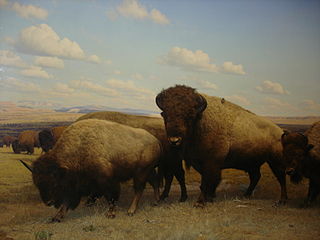
The conservation of taxidermy is the ongoing maintenance and preservation of zoological specimens that have been mounted or stuffed for display and study. Taxidermy specimens contain a variety of organic materials, such as fur, bone, feathers, skin, and wood, as well as inorganic materials, such as burlap, glass, and foam. Due to their composite nature, taxidermy specimens require special care and conservation treatments for the different materials.
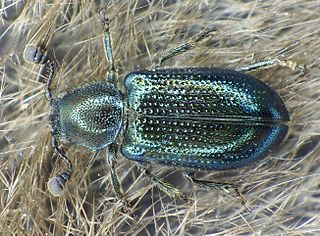
Necrobia violacea is a species of beetle in family Cleridae. Cleridae beetles are a predaceous beetle found within forest and woodland environments, and can be associated with stored food products as both pests and predators of other insects.

Jay Villemarette is the owner, founder and president of both Skulls Unlimited International, Inc. and SKELETONS: Museum of Osteology.


















